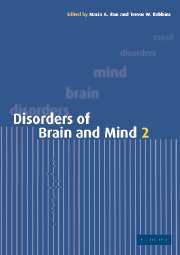Book contents
- Frontmatter
- Contents
- List of contributors
- Preface
- Part I Genes and behaviour
- Part II Brain development
- Part III New ways of imaging the brain
- Part VI Imaging the normal and abnormal mind
- Part V Consciousness and will
- Part IV Recent advances in dementia
- Part VII Affective illness
- Part VIII Aggression
- Part IX Drug use and abuse
- 19 The contribution of genetically manipulated animals to the study of stimulant and alcohol addiction
- 20 The neuropsychology of chronic drug abuse
- Index
- Plate section
- References
19 - The contribution of genetically manipulated animals to the study of stimulant and alcohol addiction
from Part IX - Drug use and abuse
Published online by Cambridge University Press: 19 January 2010
- Frontmatter
- Contents
- List of contributors
- Preface
- Part I Genes and behaviour
- Part II Brain development
- Part III New ways of imaging the brain
- Part VI Imaging the normal and abnormal mind
- Part V Consciousness and will
- Part IV Recent advances in dementia
- Part VII Affective illness
- Part VIII Aggression
- Part IX Drug use and abuse
- 19 The contribution of genetically manipulated animals to the study of stimulant and alcohol addiction
- 20 The neuropsychology of chronic drug abuse
- Index
- Plate section
- References
Summary
Introduction
As in other areas of biology, behavioural neuroscience has been revolutionized in the past decade by advances in genomics. The sequencing of the human genome, as well as those of the mouse and of invertebrate species, has opened the prospect of understanding the extent to which psychiatric conditions depend upon variations in genetic makeup. At the same time, advances in genetic technology have made studies of functional genomics possible. The ability to manipulate the genetic makeup of organisms, such as the mouse, by specific targeting of mutations in selected genes has provided an impetus for behavioural scientists to match technical advances in genomics with technical developments of their own. The area of drug abuse and dependence has been among the beneficiaries of these developments. However, even after such a short period of experience, it has become clear that the new science of behavioural genomics not only offers opportunities, but also raises questions that are peculiar to the new field.
Knockouts and transgenics
Two basic techniques are used to generate mice with ‘targeted mutations’, either by deletion of the gene of interest (knockouts, ‘null mutants’ or -/-), or by inserting a novel gene or multiple copies of the gene of interest into the genome (transgenics). While the terms ‘knockout’ and ‘transgenic’ are sometimes used interchangeably when referring to genetically engineered organisms, they do represent two distinctly different procedures, as illustrated in Figure 19.1, with separate problems resulting from the method used for their generation.
- Type
- Chapter
- Information
- Disorders of Brain and Mind , pp. 421 - 446Publisher: Cambridge University PressPrint publication year: 2003

